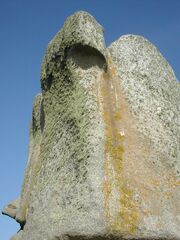Assessment |
Biopsychology |
Comparative |
Cognitive |
Developmental |
Language |
Individual differences |
Personality |
Philosophy |
Social |
Methods |
Statistics |
Clinical |
Educational |
Industrial |
Professional items |
World psychology |
Biological: Behavioural genetics · Evolutionary psychology · Neuroanatomy · Neurochemistry · Neuroendocrinology · Neuroscience · Psychoneuroimmunology · Physiological Psychology · Psychopharmacology (Index, Outline)

Two lichenes species on a rock, in two different ecological niches
In ecology, a niche is a term describing the relational position of a species or population in an ecosystem. More formally, the niche includes how a population responds to the abundance of its resources and enemies (e. g., by growing when resources are abundant, and predators, parasites and pathogens are scarce) and how it affects those same factors (e.g., by reducing the abundance of resources through consumption and contributing to the population growth of enemies by falling prey to them). The abiotic or physical environment is part of the niche because it influences how populations affect, and are affected by, resources and enemies.
The description of a niche may include descriptions of the organism's life history, habitat, and place in the food chain. According to the competitive exclusion principle, no two species can occupy the same niche in the same environment for a long time.
The term 'Niche' was coined by the naturalist Joseph Grinnell in 1917, in his paper "The niche relationships of the California Thrasher." However, it wasn't until 1927 that Charles Sutherland Elton, a British ecologist, gave the first working definition of the niche concept. He was credited of saying "when an ecologist sees a badger, they should include in their thoughts some definitive idea of the animal's place in the community to which it belongs, just as if they had said 'there goes the vicar'".
The niche concept was popularized by the zoologist G. Evelyn Hutchinson in 1957. Hutchinson wanted to know why there are so many different types of organisms in any one habitat.
The full range of environmental conditions (biological and physical) under which an organism can exist describes its fundamental niche. As a result of pressure from, and interactions with, other organisms (e.g. superior competitors) species are usually forced to occupy a niche that is narrower than this and to which they are mostly highly adapted. This is termed the realized niche. G.E. Hutchinson also defined the ecological niche as a "Hypervolume". This term defines the multi-dimensional space of resources (i.e., light, nutrients, structure, etc.) available to (and specifically used by) organisms. An adaptive zone is a set of ecological niches that may be occupied by a group of species that exploits the same resources in a similar manner. (After Root, 1967)
It should be noted that "niche" of Hutchinson (a description of the ecological space occupied by a species) is subtly different than the "niche" as defined by Grinnell (an ecological role, that may or may not be actually filled by a species -- see vacant niches)
Different species can hold similar niches in different locations and the same species may occupy different niches in different locations. The Australian grasslands species, though different from those of the Great Plains grasslands, occupy the same niche. [1] Once a niche is left vacant, other organisms can fill into that position. For example, the niche that was left vacant by the extinction of the tarpan has been filled by other animals (in particular a small horse breed, the konik). When plants and animals are introduced into a new environment, they can occupy the new niches or niches of native organisms, outcompete the indigenous species, and become a serious pest.
See also[]
- Biome
- Ecotope
- Introduced species
- Information ecology
- vacant niches
External links[]
bg:Екологична ниша cs:Ekologická nika da:Niche (økologi) de:Ökologische Nische es:Nicho ecológico fr:Niche écologique he:גומחה אקולוגית lv:Ekoloģiskā niša nl:Niche pt:Nicho ecológico ru:Экологическая ниша sk:Ekologická nika fi:Ekologinen lokero sv:Ekologisk nisch zh:生态位
| This page uses Creative Commons Licensed content from Wikipedia (view authors). |